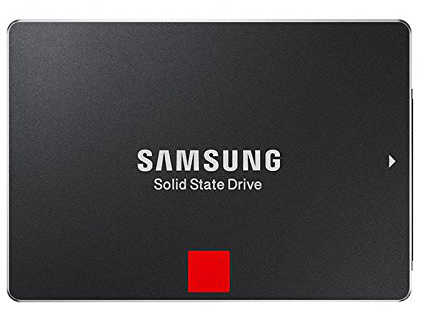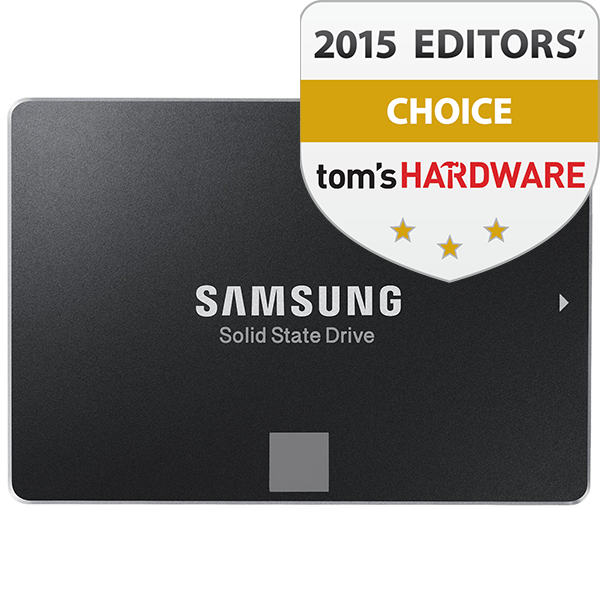Samsung 850 EVO And 850 Pro 2TB SSD Review
Samsung is updating its SATA SSD product line by adding new 2TB options to the 850 Pro and 850 Evo families. Are they any better than the existing models?
Why you can trust Tom's Hardware
Technical Specifications
MORE: Best SSDs For The Money
MORE: Latest Storage News
MORE: Storage in the Forums
Although they aren't groundbreaking, the 2TB 850 Pro and EVO drives do add some excitement to both line-ups. For the most part, Samsung simply added twice as much NAND to get to 2TB. It also doubled the on-board cache and upgraded it to low-power DDR3 (LPDDR3) for the largest capacity size. The DDR3 runs at a higher clock speed and uses less power than the older DDR2. Both increases are offset by the larger table maps (speed) and more NAND dies (power).
A new controller was necessary to support twice as many CE paths to the 32-layer V-NAND flash. This does increase interleaving, and you will see the impact of this in the performance results, even if officially, Samsung specs the 850 Pro 2TB and 850 EVO 2TB for the same performance as its 1TB models.
The 2TB capacity point really favors the 850 EVO more than the Pro. You're going to see a huge price gap right off the bat, but there's more to the story than just a $200 difference. The Samsung 850 EVO 2TB uses TurboWrite technology, a layer of emulated SLC flash that acts as a buffer for data writes. With more flash on the drive, Samsung was able to increase the amount reserved for TurboWrite. We had to push the drive really hard to figure out where the cache ended and TLC write performance began. Outside of working with massive video files in a workstation environment, you'll probably never observe writes at TLC speeds.
Both new products support Self-Encrypting Drive (SED) technology like existing models. We hope that many power users will take advantage of eDrive, Microsoft's Windows-based IEEE-1667 encryption technology, but TCG Opal is supported as well.
Samsung's documentation shows the 2TB models using slightly more power under different conditions than the 1TB versions. You may be tempted to interpret that as less notebook battery life, but in practice, that's not the case. The increased interleaving, as well as the larger TurboWrite area (850 EVO-only) yield more time away from a wall socket, actually. We'll go into more depth on this shortly.
Get Tom's Hardware's best news and in-depth reviews, straight to your inbox.
Current page: Technical Specifications
Prev Page Introduction Next Page Pricing, Warranty And Accessories
Chris Ramseyer was a senior contributing editor for Tom's Hardware. He tested and reviewed consumer storage.
-
Jeffs0418 Great article. It seems the new EVO's might go down in history as a tough act to follow.Reply
I purchased a 250GB model several months ago and love it. -
soldier44 Just picked up the 512gb version and love it. Will get another one soon for raid 0. A grand for the 2Tb wow but get what you pay for.Reply -
Jeffs0418 These are perfectly reasonable per gig prices. If you mean significantly lower prices it certainly wont be 2 years!Reply
Wait just a few short months as more 2TB consumer SSD's hit the market and watch them tumble. -
mr grim Just about to get my first SSD, been waiting forever for the tech to mature a bit and for the price to become more reasonable, my first ever SDD I have ordered is the 1TB 850 Evo that I picked up on Ebay for $450 AU, just hope the saving is worth the risk, if I purchased one locally I would be looking at around the $600 price range, these new 2TB drive would likely cost well over the $1000 mark.Reply -
uglyduckling81 Even the first Gen SSD's were mature enough to use. My first SSD was the OCZ Agility. AU$510 for 128Gb in 2010 I think. What a game changer.Reply
I only stopped using it when the laptop I had put it in got stolen last year.
The worst part of SSD's has been using someone else's PC without one. It's disgusting doing support on an OS that isn't installed on an SSD. -
AndrewJacksonZA Firstly, Tom's, I'm begging you guys, please stop with the compact charts that require clicks to see them and especially, ESPECIALLY the lazy-loading of the charts. It really breaks my focus on the article when I'm scrolling through, reading text and then all of a sudden the text shifts down and I lose my place because some graphs above it just loaded.Reply
Now that my request to you is out the way, thank you for the article. The 2TB EVO really looks amazing!! I'm not a Samsung fan, but they definitely have my round of applause for this drive, especially because of the SLC emulation. -
mapesdhs "In this section, you'll find the 850 Pro on the right side and the 850 Evo on the left. ..."Reply
Except for the two images immediately above that line. :D
SanDisk stated a while ago they wanted to ramp up to 8TB SSDs as quickly as possible, but I'll believe that when I see it. Unlikely they'd chuck out a 4TB now if they can make money from a 2TB first (really wish just once some company would properly leave the others behind instead of milking every inbetween stage of a tech as much as possible).
-
mapesdhs (Chris, trying to reach the UK site atm to edit comments results in a page redirection error)Reply
"The only drives faster than Samsung's 850 Pro and Evo 2TB in sequential writes are the 850 Pro and Evo 1TB."
Why have you used a bar graph with a non-zero origin for the results? I really hate that, it's very visually misleading. Please replace the image with a graph that has the origin at zero so it will at least be visually logical. The whole point of a bar graph is that the visual impact can allow one to infer an immediate sense of difference, something which is destroyed by using a non-zero origin.
In contrast to this, why do all the PCMark8 tests have zero origins, which have almost no results variation at all? Actually I don't know why anyone bothers with that suite, it tells one nothing useful IMO, I mean does anyone really care about Service Times for games? Level loading and to what extent SSDs can reduce in-game stuttering, sure, but then this is achieved with just about any SSD.
Anyway, please replace the non-zero-origin graph for the Seq. Write data.
Ian.
PS. Why does the Vector 180 show such an odd performance wobble as it moves up the queue depths for the seq. write test?
-
zodiacfml Actually, it was boring. Many SSDs already saturated the SATA interface, including the AHCI protocol. Yet, one would still get a Samsung SSD because of its V-NAND tech for longer NAND life.Reply

